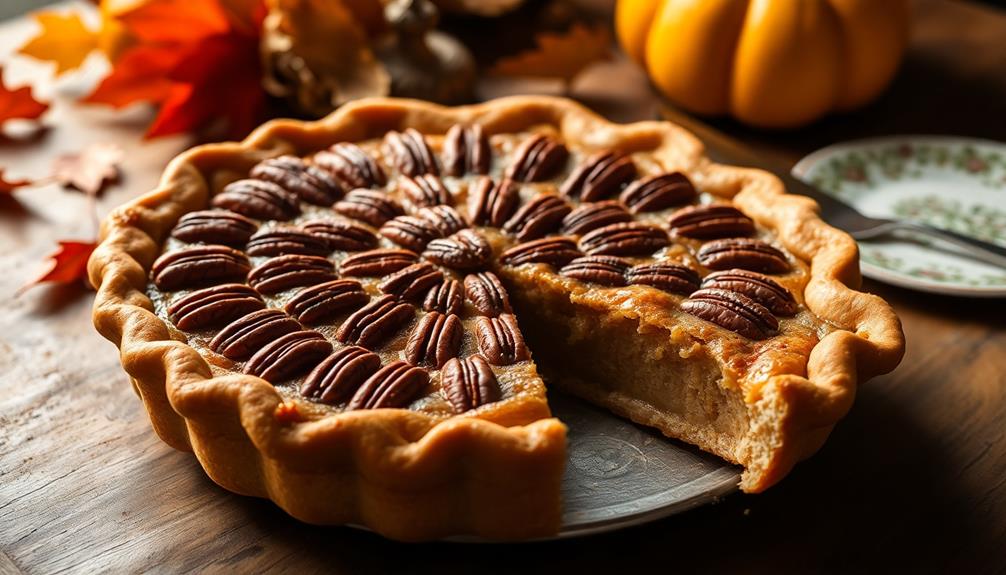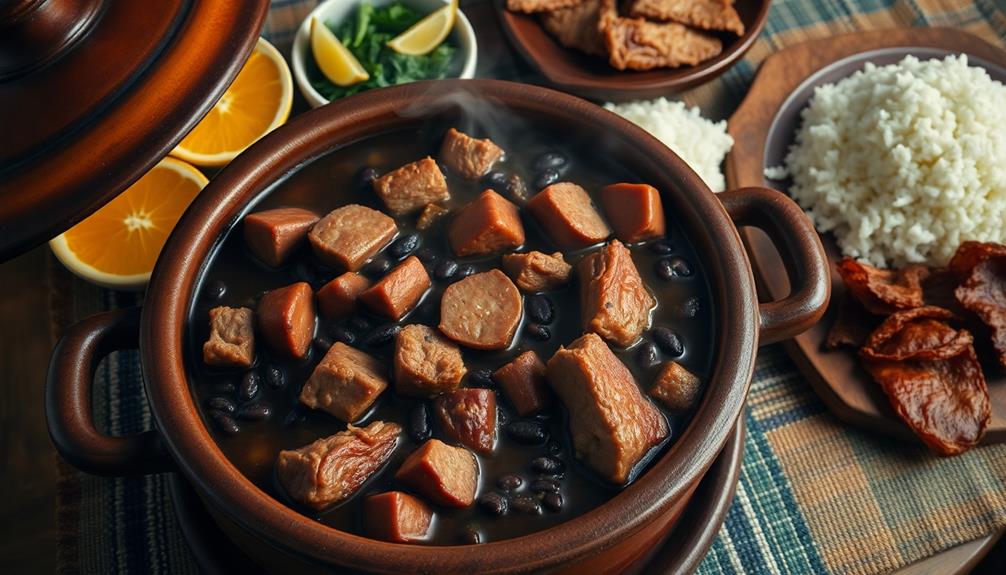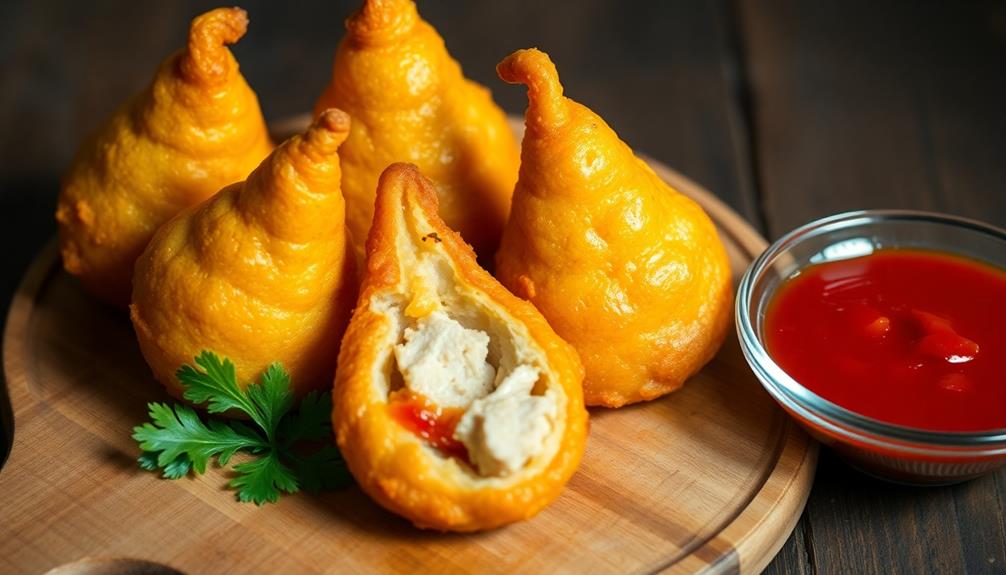Feijão Tropeiro is a delicious Brazilian dish you'll love! It's a hearty mix of beans, bacon, sausage, and manioc flour that'll fill you up and make your taste buds dance. This meal has a rich history, dating back to the 18th century when cowboys needed easy-to-make, filling food on their travels. You'll find it's super versatile – great for any time of day and perfect for sharing with family and friends. The combination of crispy bacon, fluffy eggs, and savory sausage creates a flavor explosion in your mouth. Get ready to explore a tasty piece of Brazilian culture and tradition!
Key Takeaways
- Feijão Tropeiro is a traditional Brazilian dish originating from 18th-century cowboys' need for a hearty, non-perishable meal.
- The dish combines cooked beans, bacon, sausage, and manioc flour, creating a rich and flavorful meal.
- It's versatile, serving as both a main course or side dish, often accompanied by rice and salad.
- Preparation involves cooking beans, crisping bacon, sautéing onions and garlic, and combining all ingredients with eggs.
- Feijão Tropeiro represents Brazilian culinary heritage, connecting people to the country's history and culture through food.
History
Tracing the roots of feijão tropeiro takes us back to colonial Brazil, where this hearty dish originated. You'll find its beginnings in the 18th century, when it became a staple for tropeiros, the brave cowboys who transported goods across the vast Brazilian wilderness.
These hardy travelers needed a meal that was filling, easy to prepare, and wouldn't spoil quickly on their long journeys. The tropeiros would mix beans, a staple food in Brazil, with dried meat, flour, and whatever else they could find along the way. This combination created a nutritious and delicious meal that kept them going through their arduous treks.
As time went on, the dish evolved, and different regions added their own twists to the recipe. Today, feijão tropeiro is still a beloved part of Brazilian cuisine. You'll find it served at family gatherings, festivals, and restaurants throughout the country.
It's a tasty reminder of Brazil's rich history and the ingenuity of those early travelers who created a dish that's stood the test of time.
Recipe
Feijão Tropeiro is a beloved Brazilian dish that originated from the travels of cattle drivers, known as tropeiros, who needed hearty, long-lasting meals during their journeys. This rustic and flavorful dish combines beans, bacon, sausage, and manioc flour, creating a satisfying and comforting meal. Feijão Tropeiro is a staple in Brazilian cuisine and has become a symbol of traditional country cooking. Its roots can be traced back to the early days of cattle ranching in Brazil, where farmhands and cowboys relied on simple, yet nourishing dishes to sustain them during long days of hard work. The dish’s history is intertwined with the history of feijoada, another famous Brazilian bean dish that has its origins in the country’s colonial era.
Traditional Feijão Tropeiro is known for its rich flavors and varied textures. The combination of smoky bacon, savory sausage, and creamy beans is perfectly complemented by the crispy manioc flour. This dish isn't only delicious but also a great way to use leftover beans, making it a practical and economical option for home cooks.
- 2 cups cooked pinto beans
- 200g bacon, diced
- 200g smoked sausage, sliced
- 1 large onion, diced
- 3 cloves of garlic, minced
- 2 eggs, beaten
- 1 cup manioc flour
- 2 bay leaves
- Salt and pepper to taste
- 2 tablespoons vegetable oil
- Fresh parsley, chopped (for garnish)
In a large skillet, cook the bacon over medium heat until crispy. Add the sliced sausage and cook for a few minutes until browned. Remove the meat and set aside.
In the same skillet, sauté the onion and garlic until translucent. Add the cooked beans, bay leaves, and season with salt and pepper. Stir in the beaten eggs and cook until they start to set.
Add the manioc flour gradually, stirring constantly to prevent lumps. Return the bacon and sausage to the skillet and mix well. Cook for a few more minutes until everything is heated through and the manioc flour is toasted. Remove the bay leaves before serving.
For the best results, use freshly cooked beans rather than canned ones, as they'll have a better texture and flavor. The manioc flour, also known as farofa, can be adjusted to your preference – add more for a drier dish or less for a moister consistency.
Don't forget to season the dish well, as the beans can absorb a lot of flavor. Feijão Tropeiro is often served as a side dish but can also be enjoyed as a main course, accompanied by rice and a simple green salad.
Cooking Steps
To make Feijao Tropeiro, you'll start by soaking the beans overnight, which helps them cook faster and more evenly.
Once you're ready to cook, you'll crisp up some bacon in a pan, then sauté onions and garlic until they're fragrant and golden.
Next, you'll add the beans to the bacon mixture, stirring in some sausage and eggs to create a hearty, flavorful dish that's sure to satisfy your hunger.
Step 1. Soak Beans Overnight

The humble bean takes center stage in this crucial first step of preparing Feijão Tropeiro. You'll want to start by soaking your beans overnight, which is super important for making them tasty and easy to cook.
First, pick through your beans to remove any small stones or damaged ones. Then, rinse them well under cool water until it runs clear.
Next, place your beans in a large bowl and cover them with plenty of water. Make sure there's about two inches of water above the beans, as they'll expand while soaking. You can add a pinch of salt to the water if you'd like, but it's not necessary.
Now, let your beans rest on the counter or in the fridge overnight, or for at least 8 hours.
In the morning, you'll notice the beans have grown bigger and softer. Drain and rinse them one more time before cooking.
This soaking process helps reduce cooking time and makes the beans more digestible. It's like giving your beans a spa day before they become the star of your Feijão Tropeiro!
Step 2. Cook Bacon Until Crispy
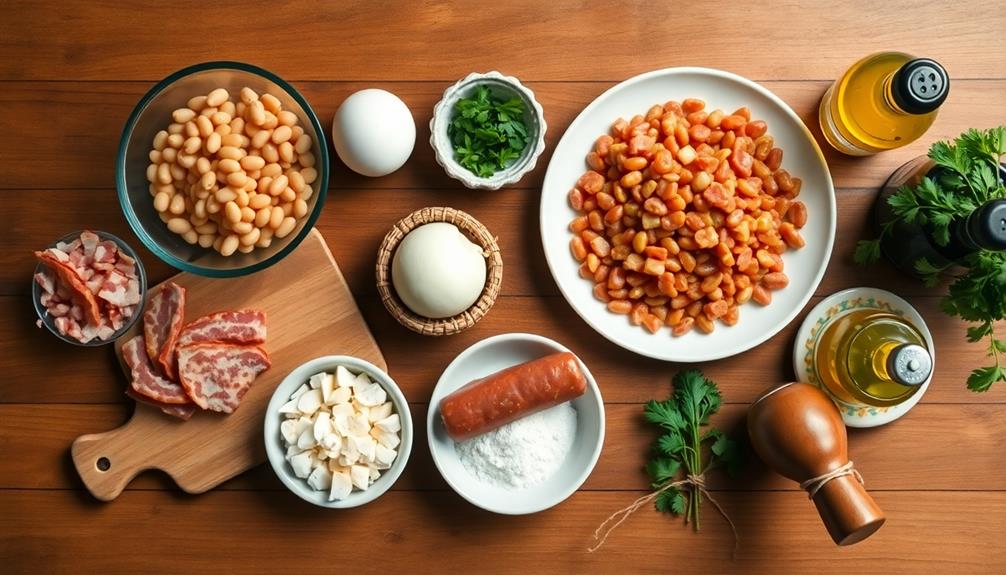
Cooking bacon until crispy is a key step in creating the rich, savory foundation of Feijão Tropeiro. To start, you'll want to grab a large skillet or frying pan and place it over medium heat.
Once it's hot, carefully lay your bacon strips in the pan, making sure they don't overlap. As the bacon cooks, you'll hear it sizzle and see it start to shrink.
Keep an eye on your bacon and flip it every few minutes. You're looking for that perfect golden-brown color and crispy texture. Don't rush this part – it usually takes about 10 to 15 minutes for the bacon to get nice and crispy.
If you notice a lot of grease in the pan, you can carefully pour some off, but leave a little for flavor.
When your bacon is done, transfer it to a plate lined with paper towels. This will help soak up any extra grease.
Let it cool for a few minutes, then crumble it into bite-sized pieces. Your crispy bacon bits are now ready to add a delicious crunch and smoky flavor to your Feijão Tropeiro!
Step 3. Sauté Onions and Garlic
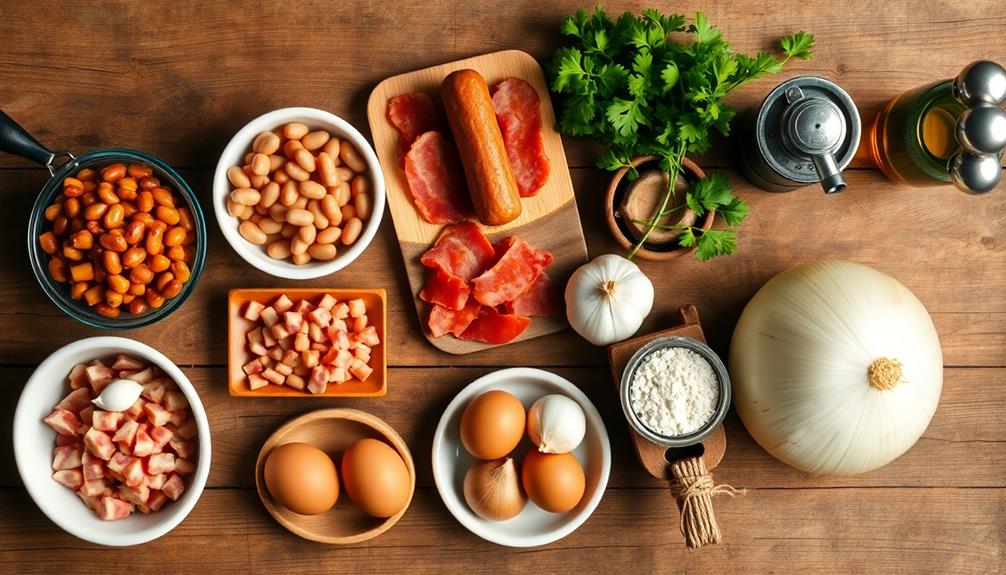
After crisping the bacon, it's time to build the flavor base for your Feijão Tropeiro.
Turn down the heat to medium and add finely chopped onions to the same pan. You'll want to use about one large onion or two medium ones. As the onions start to sizzle, you'll smell their sweet aroma filling your kitchen.
Stir the onions frequently with a wooden spoon, letting them cook until they become soft and translucent. This usually takes about 5 minutes.
Now, it's time to add the garlic! Toss in 3-4 minced garlic cloves and continue to sauté for another minute or two. The garlic will become fragrant, but be careful not to let it burn.
As you're sautéing, you might notice some brown bits stuck to the bottom of the pan. Don't worry – that's flavor gold! Use your spoon to scrape these bits up and mix them with the onions and garlic.
This step is crucial for developing the rich, savory taste that makes Feijão Tropeiro so delicious. Your kitchen will smell amazing by now!
Step 4. Add Beans to Bacon Mixture

Now that you've created a flavorful base, it's time to add the star ingredient – the beans. Grab your drained and cooked beans and gently pour them into the pan with the bacon mixture.
You'll want to use a large spoon or spatula to fold the beans in, making sure they're evenly distributed throughout. As you're mixing, you'll notice the beans starting to absorb all those delicious flavors from the bacon, onions, and garlic.
It's like they're soaking up a tasty bath! Keep stirring gently, being careful not to mash the beans. You want them to stay whole and intact.
Once the beans are well-combined with the other ingredients, let them cook for about 5 minutes. This will help them warm up and really take on the flavors of the dish.
As they're cooking, you might hear a soft sizzling sound – that's the beans getting even more delicious! If the mixture seems a bit dry, you can add a splash of water or broth to keep everything moist and flavorful.
Step 5. Add Sausage and Eggs

The final protein powerhouses are ready to join the party. It's time to add the sausage and eggs to your feijãao tropeiro!
First, grab your favorite Brazilian sausage, like linguiça, and slice it into bite-sized pieces. Toss these savory morsels into the pan with your bacon and bean mixture. Let them sizzle and dance together, releasing their delicious flavors.
Now, crack a few eggs into a bowl and give them a quick whisk. Pour the beaten eggs into the pan, stirring gently as they cook. Watch as they form soft, scrambled pieces that'll add a creamy texture to your dish. The eggs will soak up all the amazing flavors from the beans, bacon, and sausage.
Keep stirring everything together, making sure the eggs are fully cooked and the sausage is heated through. The aroma filling your kitchen will be irresistible!
This combo of sausage and eggs brings a whole new level of yumminess to your feijãao tropeiro. It's like a protein party in a pan, and you're the chef in charge!
Final Thoughts
Feijao Tropeiro's culinary journey from humble trail food to beloved national dish showcases Brazil's rich cultural tapestry.
As you've learned, this hearty meal combines beans, bacon, sausage, and eggs into a delicious, filling dish that's perfect for any time of day. It's a testament to how simple ingredients can come together to create something truly special.
When you make Feijao Tropeiro at home, you're not just cooking a meal; you're participating in a centuries-old tradition.
Remember, the key is to layer flavors and textures, from the crispy bacon to the fluffy eggs. Don't be afraid to experiment with different types of beans or sausages to make it your own!
This dish is more than just food; it's a way to connect with Brazilian culture and history.
Whether you're sharing it with family or friends, Feijao Tropeiro is sure to bring smiles and satisfaction to the table.
Frequently Asked Questions
Can Feijão Tropeiro Be Made Vegetarian?
You can definitely make a vegetarian version of this dish. Simply omit the meat and bacon, replacing them with plant-based alternatives like smoked tofu or tempeh. You'll still get a flavorful, hearty meal that's true to the original.
How Long Does Feijão Tropeiro Last in the Refrigerator?
You'll want to consume your leftover dish within 3-4 days when refrigerated properly. It's best to store it in an airtight container. For longer storage, you can freeze it for up to 3 months.
What Are the Best Side Dishes to Serve With Feijão Tropeiro?
You'll love pairing feijão tropeiro with white rice, couve (collard greens), and farofa. Don't forget to add a side of vinaigrette salsa or fresh salad. These accompaniments complement the dish's rich flavors perfectly.
Is Feijão Tropeiro Suitable for Freezing and Reheating?
Yes, you can freeze and reheat feijão tropeiro. It's best to store it in an airtight container for up to 3 months. When reheating, add a little water and stir occasionally to maintain its texture.
Are There Regional Variations of Feijão Tropeiro Across Brazil?
You'll find regional variations of this dish across Brazil. In Minas Gerais, it's often made with pork, while in São Paulo, you might see it with linguiça. Ingredients and preparation methods can vary by region.

